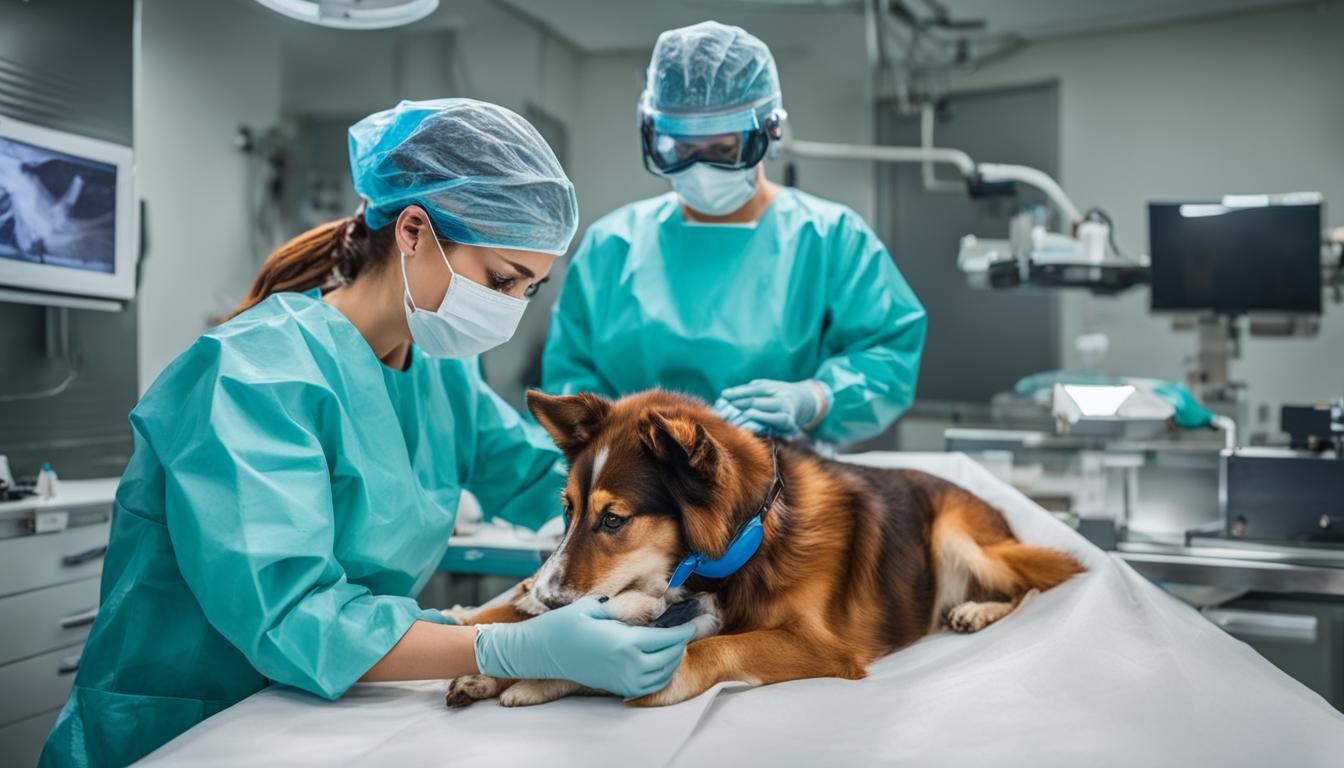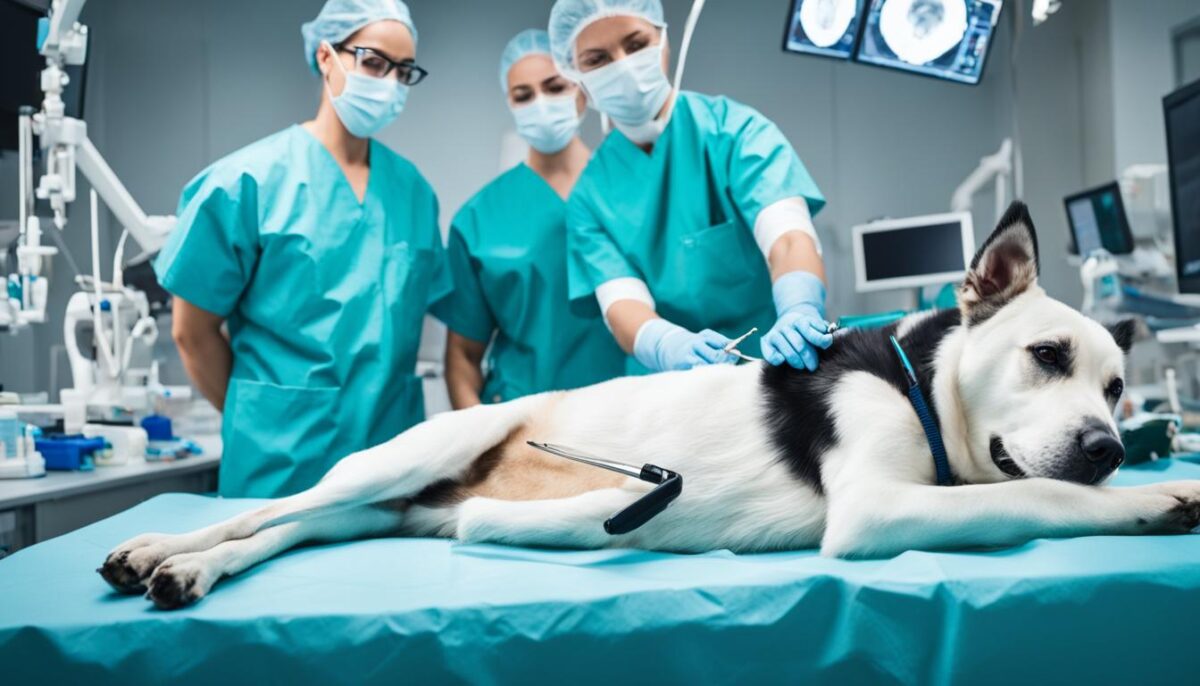Have you ever wondered if you can safely spay your dog while she’s in heat? It’s a question many pet owners face. While fixing a dog during estrus was once a topic of debate, things have changed. Thanks to skilled vets and advanced surgery methods, canine ovariohysterectomy during a dog’s estrus cycle spay procedure can be done with care. But, there are still special things to think about, like more bleeding and tender tissues.
Doctors who take care of animals, like Sara A. Colopy, DVM at the University of Wisconsin, highlight the need for careful handling of tissue to prevent tearing. Plus, Lauren LaRue, DVM, from UC Davis mentions how a dog’s stretchy reproductive parts can actually help during the spay surgery. Still, owners should know about the possible extra risks and costs that come with this type of spay.
Key Takeaways
- Fixing a dog in heat is now more common with the right skills and care.
- Surgeons must handle tissues gently to prevent extra bleeding.
- The dog’s stretchy insides may help during surgery.
- Owners need to know this surgery may cost more and need more care.
- It’s important to pick a vet with lots of experience for this surgery.
Understanding the Heat Cycle and Spaying
Hey there, pet parents! Let’s dive into a topic that’s super important for your furry friend’s health: the canine heat cycle and spaying. Have you ever wondered about the best time to spay your dog to keep her healthy and happy? Let’s break it down together.
Your little girl will likely go through her first dog estrus phase, or heat cycle, when she’s about six months old if she’s a smaller breed, and sometimes it could be up to two years old if she’s one of the larger breeds. This cycle is not just a ‘doggy period’—it’s much more. It lasts for about 2 to 4 weeks, and during this time, her body is getting ready for potential puppies. Her uterus and ovaries get all swollen, and the blood vessels get larger, which can make any surgery, like spaying, a bit trickier.
Why trickier, you ask? Well, let’s say it’s like trying to tie a balloon when it’s filled with water instead of blowing it up with air. It can be done, but you need to be extra careful not to pop it. That’s why it’s super important to talk to your vet about spay timing since they know how to handle these sensitive surgeries best.
Generally, veterinarians reckon it’s best to schedule the spay surgery before the first heat cycle. This helps reduce the risk of breast cancer in your pup and keeps her away from emergency situations like pyometra, which is not fun for anyone. But, if you didn’t manage to spay your pooch before her first heat, don’t worry! Spaying during the heat is still possible, and the pros can totally handle it. They just have to make some careful decisions in the surgery room.
So remember, keeping your dog’s reproductive health in check is super important, and timing the spay can make all the difference. If you have any questions, always reach out to your vet. They’re like the superheroes for your dog’s health!
Can a Dog Get Fixed While in Heat?
When your furry friend is in heat, you might wonder if it’s the right time for spay surgery. Let’s talk about what happens during this time and what vets do to help.
Assessing Vascular Concerns During Estrus
During a dog’s heat, the canine blood vessel engorgement is notable. “Estrus complications” arise because there’s more blood flow to the uterus. Simply put, this means that there are bigger blood vessels and more of them, which makes the surgery a bit tricky.
Adjusting Surgical Techniques for Dogs in Heat
Surgical adjustments for spaying during this time are super important. Vets need to be gentle and may use special instruments to see things better in your dog’s belly. They take care to tie off blood vessels tightly because of all that extra blood!
The Role of Veterinary Expertise and Experience
Having a seasoned veterinarian who is very good at these surgeries can make a big difference. The more practice a vet has with specialized spay methods, the better they can care for your pooch. Some vets use cool tools and share tips with each other to get really good at helping dogs in heat.
Your pet is in good hands with a vet who’s got lots of spay procedure proficiency. They know what to do, even when there’s a bit more blood than usual. Trust them to look after your four-legged friend!
Risks and Benefits of Spaying During Heat
When you consider spaying your dog during her heat cycle, you should know both the good and the not-so-good points. One of the big worries about this operation is spay procedure complications. The surgery might take longer, and your dog could bleed more than usual. Still, there are advantages of spaying. It can keep her from getting serious sicknesses and from having puppies when you’re not ready.
Let’s break it down more:
- Good Elasticity: Her insides are stretchier during heat, which helps the vet work on her.
- No Puppies: Spaying means no surprise puppies at your doorstep.
- Less Sickness: Without all her baby-making parts, she’s less likely to get sick with things like infections (pyometra) or cancer.
There are also some risks:
- Longer Surgery: The vet might need more time to fix her up.
- More Bleeding: She might lose more blood than if she wasn’t in heat.
- Keep Boys Away: After surgery, it’s extra important to stop her from playing with male dogs, so she doesn’t hurt herself.
In the end, you and the vet have to think about the good and the not-so-good before deciding. It’s about your dog’s safety and canine health risks. So, talk to your vet, ask questions, and choose what’s best for your furry friend.
Post-Surgery Recovery for Dogs Spayed in Heat
After your dog has been spayed, especially during her heat cycle, you can expect that she might need some extra care during recovery. This extra care is all about giving your furry friend the best chance at a quick and smooth dog surgical healing process. Here are some tips to help your dog during her recovery after spaying:
- Keep her in a quiet place away from other pets or kids to help her rest.
- Try to keep your dog from running or jumping for a few weeks after surgery.
- Make sure she wears a cone (also called an Elizabethan collar) to stop her from licking her surgery spot.
- Look at the surgery area every day to make sure it looks okay and there’s no bleeding or other fluid.
- If you see anything you’re worried about, like swelling or bleeding, call your vet.
Remember, your dog may still act like she’s in heat for a short while after her operation. You’ve got to keep her safe from male dogs during this time. Stick to these steps, and you’ll provide the best possible canine postoperative care for your pup.
Conclusion
When deciding on the right time to spay your dog, you’ll want to think carefully about what’s best for her health and well-being. It’s not just about picking a date on the calendar. The risks involved, especially if she’s in heat, and the chances of her getting pregnant are serious things to consider. Every dog is different, so it’s smart to chat with your vet about the perfect timing for the surgery. You’re making a choice that keeps your pup healthy, and that’s what being a responsible dog owner is all about.
When Timing Matters: Making an Informed Decision
If your furry friend is in heat, it might seem like a good idea to spay her right away. But hold on! It’s really important to talk it over with your vet. They know their stuff and can help you figure out the best time for the spay surgery. This chat might cover things like how old your dog is, her health, and where she’s at in her heat cycle. Knowing all this helps you both make an informed veterinary choice that’s just right for your dog.
Alternative Options and Waiting It Out
Sometimes, waiting until your dog’s heat is over is the wisest move. You might even use some medicine to help pause her cycle. Keeping her inside or away from male dogs at a kennel is a smart idea to prevent any unplanned puppies. And did you know there are different ways to spay? The laparoscopic spay is one such surgery that’s less rough on your dog and has fewer risks. If you decide to delay spaying, experts usually say to wait about eight weeks after her heat cycle. This gives her body time to get back to normal, making the surgery safer. Remember, with these options, you’re putting your dog’s health first, and that’s the best thing you can do for her.
FAQ
Is it possible to safely spay dogs in heat?
Yes, it is possible to safely spay dogs in heat. Veterinary advancements and skilled surgical techniques have made the estrus cycle spay procedure more common, though it requires careful handling due to the increased vascularity of the reproductive organs.
What should be considered when understanding the canine heat cycle in relation to spaying?
When considering spaying, it’s important to take into account the dog’s estrus phase, which is characterized by a swollen uterus and ovaries, and a higher risk of bleeding. Timely decision-making is crucial for reproductive health in dogs.
Can vascular concerns during a dog’s estrus phase be managed during a spay surgery?
Yes, managing vascular concerns is possible during a dog’s estrus phase. Surgeons need to make precise adjustments for engorgement and increased blood supply to prevent excessive bleeding during the canine ovariohysterectomy.
Are there special surgical techniques for spaying a dog in heat?
Yes, specialized spay methods, such as gentle tissue handling and the use of specific surgical tools like a Balfour retractor, are employed when fixing a dog during estrus.
How important is veterinary expertise when spaying a dog during its heat cycle?
Veterinary surgical expertise is critical when spaying a dog during its heat cycle. A seasoned veterinarian with spay procedure proficiency can significantly reduce the risks associated with the surgery.
What are the risks and benefits of spaying a dog during its heat cycle?
While there are increased risks such as excessive bleeding and a more delicate surgery, there are also advantages, like reducing the chance of unwanted pregnancy and diseases like pyometra and mammary tumors.
What does postoperative care for dogs spayed in heat entail?
Postoperative care for dogs spayed in heat involves close monitoring for signs of infection or bleeding, restricting activity, using cones to prevent licking, and ensuring the dog remains away from males to avoid complications such as semen peritonitis.
When should you consider timing the spay surgery for your dog?
The timing of the spay surgery should be discussed with your veterinarian. Factors to consider include the dog’s age, breed, and health status, as well as the potential for the dog to become pregnant. It’s important for responsible dog ownership to make an informed decision based on these factors.
Are there alternatives to spaying a dog while it’s in heat?
Yes, alternatives include waiting until the heat cycle concludes, using medications to pause the cycle, or considering a laparoscopic spay, which is less invasive. Delaying spaying until the reproductive tract has normalized is also advised.


